Deciding between Squarespace vs Framer brings two very different website-building experiences to the table. Squarespace is ideal for users who want polished, ready-to-go designs with minimal effort, while Framer caters to those looking for more freedom to create highly customized and interactive sites. This article will take a closer look at how these two platforms compare to help you determine which one aligns with your web design vision. With their distinct strengths, both Squarespace and Framer provide exciting opportunities for crafting unique, professional, and visually engaging websites.
Which one is the best for ecommerce: Squarespace or Framer?
 8.2
8.2
 5.9
5.9
Verdict: If you’re looking for a powerful, all-in-one ecommerce platform, Squarespace is the better choice. It comes with a full set of built-in features, while Framer depends on third-party integrations and doesn’t offer native ecommerce support.
- Squarespace: Is one of the tops when it comes to ecommerce. It offers a user-friendly interface, secure payment options, built-in marketing tools, and SEO features. With around 50 customizable ecommerce templates and flexible payment gateways, it’s a great option for businesses wanting a professional online store. When comparing Squarespace and Framer, Squarespace stands out for its seamless all-in-one solution and simplicity.
- Framer: While Framer is excellent for design and customization, it lacks built-in ecommerce features. Instead, it relies on integrations with platforms like Ecwid to handle online sales. Framer’s strength is in its design flexibility and AI-driven tools, but it’s not the best fit for those focused on creating an ecommerce website.
Which one is the best for informational and business websites?
 8.4
8.4
 7.5
7.5
Verdict: For creating informational business websites, Squarespace is the better option, offering a more user-friendly experience and a higher rating in this category.
- Squarespace: Squarespace makes website creation simple with its intuitive interface and a wide variety of professional templates. It’s perfect for users who want to build attractive, functional websites without dealing with complex design elements. Its score of 8.4 highlights its strength in this area, making it an excellent choice for those seeking an easy solution.
- Framer: Framer offers more customization and advanced design features but comes with a steeper learning curve. While it has a solid score of 7.5, Framer may not be the best fit for beginners or users looking for a straightforward website builder. In a comparison between Squarespace and Framer, Squarespace stands out for its ease of use and well-rounded features for informational websites.
Squarespace vs Framer: Detailed comparison
Design functionalities & templates
Design FunctionalitiesRepresents how well each platform allows for creative design and customization of websites.Score Components:
- Template Variety (30%): Range and quality of design templates.
- Customization (30%): Flexibility and options for design alterations.
- User Interface (20%): Ease and intuitiveness of the design process.
- Responsiveness (10%): Adaptability to different devices and screen sizes.
- Innovation (10%): Unique design features and tools.
 8.0
8.0
 8.5
8.5
🏆 Winner: Framer. If you want more creative control, a broader range of design features, and access to a larger number of templates, Framer is the top choice.
Squarespace offers a strong selection of over 120 pre-designed templates, making it easy to create a website for various needs, whether it’s a creative portfolio, a professional business site, an online store, or a personal blog. These templates are designed for different industries, offering a polished look right out of the box. However, Framer excels in offering even more design flexibility and customization.
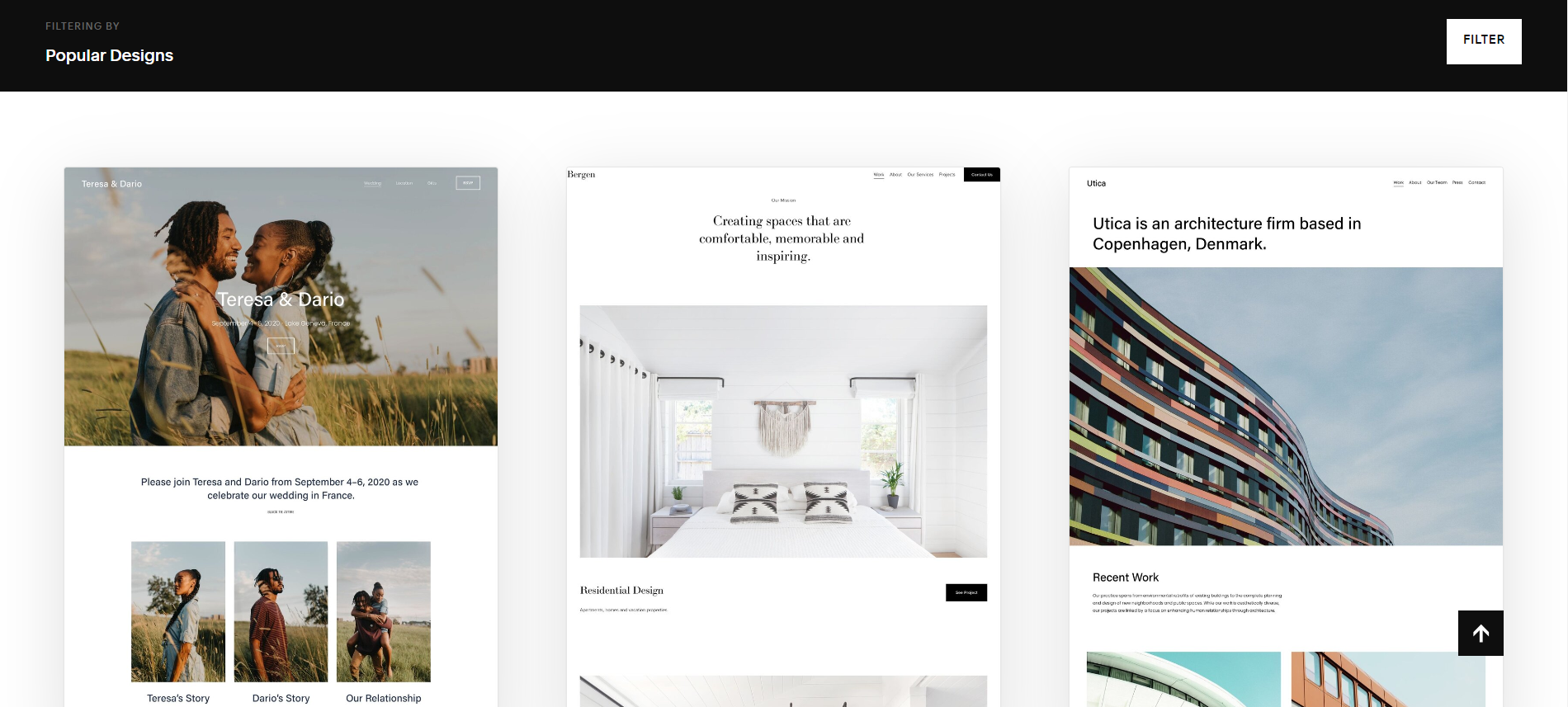

Framer offers a large selection of over 1,000 customizable templates, far surpassing Squarespace’s range. These templates accommodate a variety of industries and project needs, giving users the flexibility to create highly tailored designs. Framer tops with its advanced design and prototyping features, including responsive design, real-time collaboration, and the ability to easily import from other design tools. This makes Framer a standout choice for those who need more creative control and dynamic functionality, especially for more complex or interactive projects.
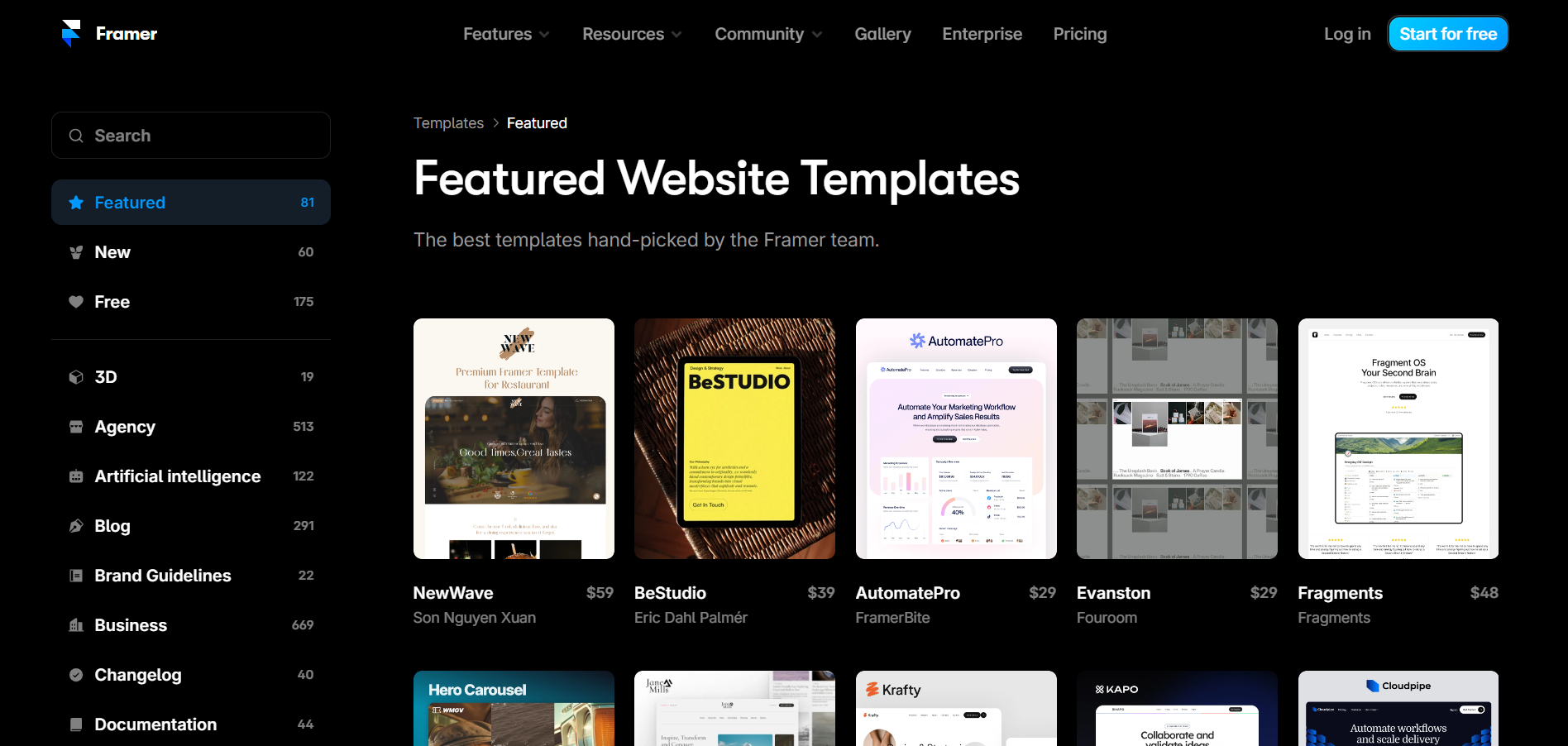

Get a head start on website creation with AI
Create a custom website tailored to your business needs 10X faster with 10Web AI Website Builder!
Ease of use
Ease of useReflects the platform’s overall user-friendliness.Score
Components:
- Learning curve (40%): Quickness and ease of getting started.
- Interface design (30%): Simplicity and intuitiveness of layout.
- User guidance (20%): Quality of tutorials and support.
- Flexibility (10%): Adaptability to various user skills.
 8.3
8.3
 7.1
7.1
🏆 Winner: Squarespace. With a score of 8.3, Squarespace is highly regarded for its user-friendly interface and simple navigation, making it ideal for anyone looking for a quick and easy website creation experience. In comparison, Framer scores 7.1. While it also offers an intuitive interface, its focus on interactive design and motion can present a steeper learning curve for complete beginners.
Learning Resources
🏆 Winner: Tie. Both Squarespace and Framer provide excellent learning resources for users at all skill levels. Squarespace features a comprehensive Help Center, easy-to-follow video tutorials, live webinars, a helpful blog, and an active community forum. Framer, on the other hand, offers in-depth courses and lessons through Framer Academy, covering topics like scroll animations, content management systems (CMS), and localization. Both platforms guarantee that users have plenty of support as they learn and grow.
For ecommerce
EcommerceMeasures the platform’s effectiveness in supporting online business activities.Score Components:
- Ecommerce themes and templates (20%): Variety and design of templates.
- Product management (25%): Ease of managing and organizing products.
- Payment options (25%): Variety and convenience of payment methods.
- Ecommerce features (20%): Features for managing an ecommerce store.
- Integration (10%): Compatibility with external e-commerce tools and services.
 8.2
8.2
 5.9
5.9
Squarespace provides a full-featured ecommerce solution, offering an intuitive interface, customizable templates, secure payment processing, flexible shipping options, automated tax calculations, built-in marketing tools, SEO optimization, and detailed analytics. It’s designed to handle all aspects of running an online store effectively.
In contrast, Framer lacks native ecommerce capabilities and relies on third-party integration through Ecwid’s free shopping cart extension to offer basic ecommerce functionality. This makes Squarespace a stronger choice for businesses focused on building and managing an online store.
 |
 |
|
|---|---|---|
Ecommerce themes and templates |
7.5 |
7.0 |
Product page customization |
7.0 |
5.5 |
Payment processing and commissions |
7.8 |
6.5 |
POS capabilities |
6.5 |
3.0 |
Payment gateways |
7.5 |
6.0 |
Product numbers |
6.8 |
6.0 |
Additional ecommerce features |
7.2 |
5.5 |
Squarespace ecommerce features:
- Intuitive interface
- Secure payment processing
- Built-in marketing tools
- SEO optimization
- Website analytics
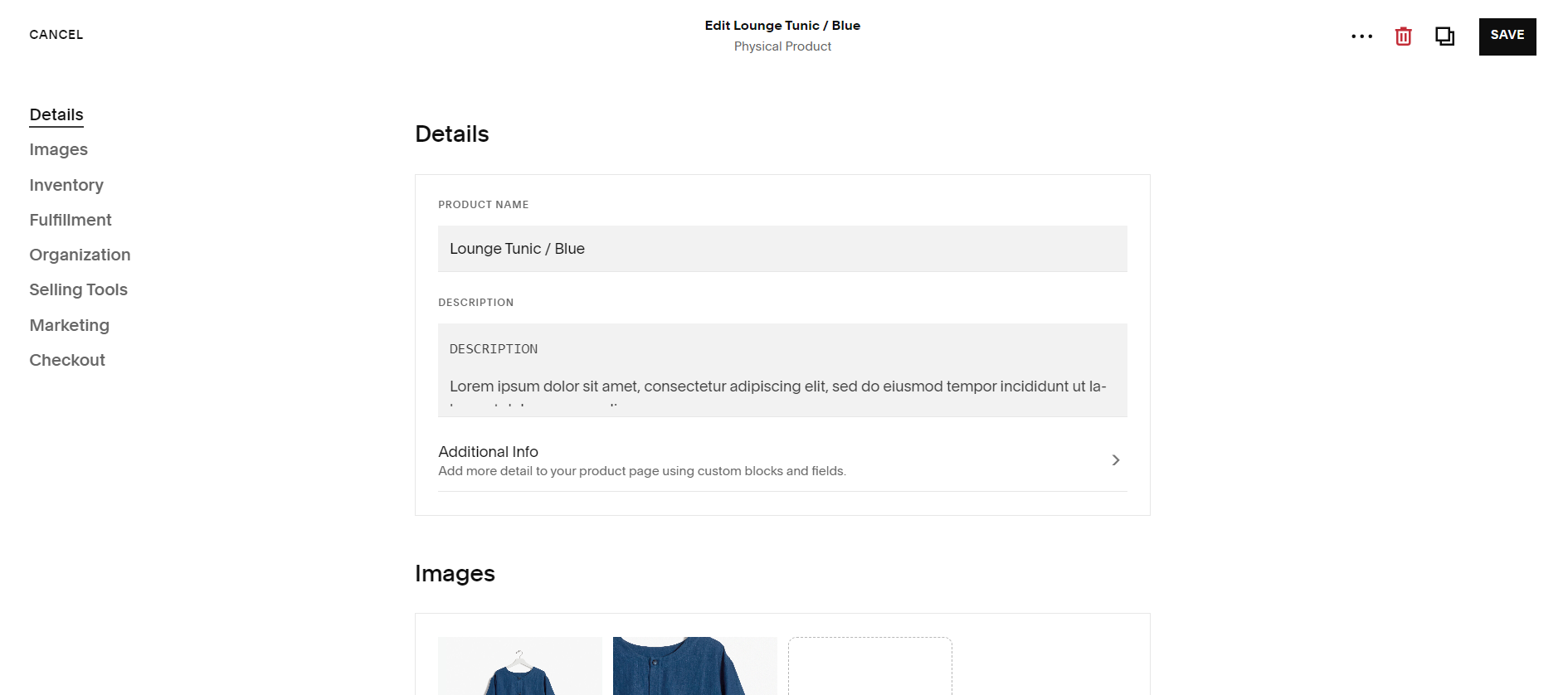
Framer ecommerce features:
- Ecwid integration
Ecommerce themes & templates
Squarespace offers around 50 ecommerce templates designed for industries like fashion, beauty, home goods, and technology. These templates vary from clean and minimalist to bold and colorful, accommodating a range of brand aesthetics and product types. With features like product sliders and featured collections, Squarespace’s templates are crafted to boost visual appeal and customer engagement.
In comparison, Framer provides 97 ecommerce-specific templates, offering more variety for businesses. These templates are highly customizable, allowing users to easily adjust colors, fonts, and layouts, as well as integrate essential ecommerce tools. With both free and paid options available, Framer caters to businesses of all sizes looking to improve their online presence and sales capabilities.
Product page customization
Customizing product pages in Squarespace offers flexibility in layout, design, and interactive features. You can select from templates, adjust colors, fonts, and content, and improve customer engagement with features like customizable buttons, wish lists, product comparisons, reviews, and related products. For more advanced customization, Squarespace supports custom code injection and third-party app integrations. However, there are some limitations, such as a fixed core page structure and the need for technical expertise for more complex changes. Additionally, free templates offer fewer customization options compared to premium ones.
Framer, while focused on expanding design possibilities for ecommerce, lacks built-in ecommerce functionalities. It relies heavily on integrations with platforms like Shopify and Ecwid to manage online stores. Though Framer allows for product page customization, these changes are typically limited to design and layout modifications, without the deeper ecommerce features that platforms like Squarespace provide.
Payment processing
Squarespace offers flexible payment processing for online stores through integrated gateways like Stripe and PayPal. For specific needs, external gateways can also be set up. Depending on your plan and the payment method, transaction fees may apply. Squarespace guarantees security with PCI compliance and fraud prevention, and additional features include payment links, support for subscriptions, and the ability to accept international payments in various currencies.
However, Framer supports payment processing via Stripe, offering a range of payment options such as one-time payments, subscriptions, and more, all without needing coding expertise. While specific transaction fees aren’t outlined by Framer, these typically follow Stripe’s pricing structure. Framer focuses heavily on online transactions and ecommerce integrations, though it doesn’t mention native point-of-sale (POS) functionality. For the latest details on fees and features, it’s best to consult Framer or Stripe directly.
Website Editors
Website EditorsEvaluates the platforms’ website building and editing capabilities.Score Components:
- Customization tools (40%): Range and power of editing features.
- Editor usability (30%): User experience within the editor.
- Design flexibility (20%): Freedom in layout and design changes.
- Update and maintenance ease (10%): Simplicity of updating and maintaining the site.
 8.3
8.3
 7.6
7.6
🏆 Winner: Squarespace. With a score of 8.3, Squarespace tops at providing a user-friendly, drag-and-drop editor that allows for easy website creation without the need for coding. Its visually appealing templates and flexible customization options benefit both beginners and experienced users. The real-time editing experience lets you see changes instantly, guaranteeing a smooth design process. Squarespace prioritizes content and offers mobile-responsive designs along with practical features like forms, social media integration, and online stores. It also integrates seamlessly with external tools to extend its capabilities, making it a useful platform for a variety of website needs.
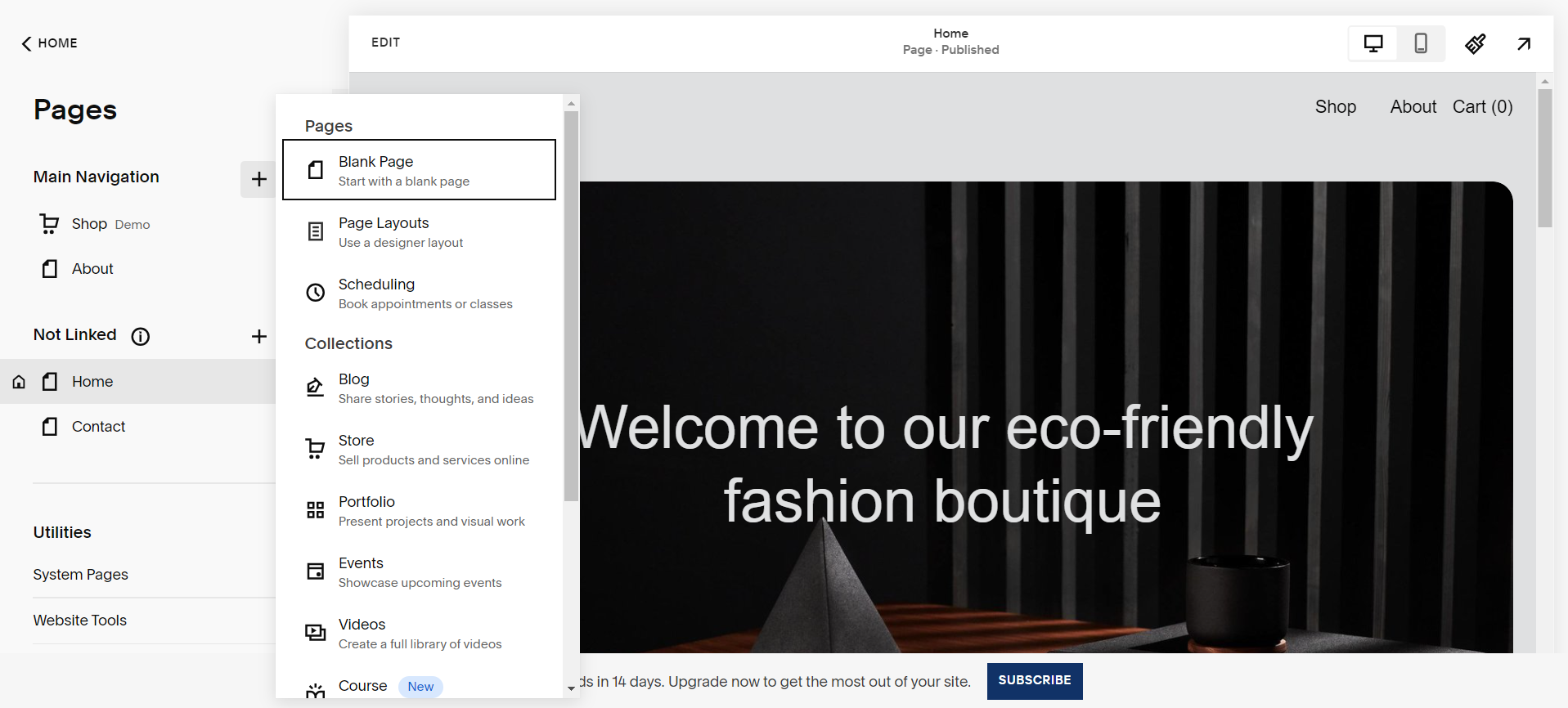
Framer’s website builder editor, with a score of 7.6, is tailored for high-fidelity prototyping and complex animations, making it ideal for designers and developers. It provides a powerful suite of tools for building interactive, responsive designs, including a wide selection of pre-built components, real-time collaboration features, and seamless integration with other design tools and workflows.
Framer’s editor allows users to create detailed animations, fine-tune interactions, and test designs across various screen sizes and devices. Its code export feature also facilitates a smooth handoff from design to development, making it a versatile option for teams focused on building polished, user-focused websites.
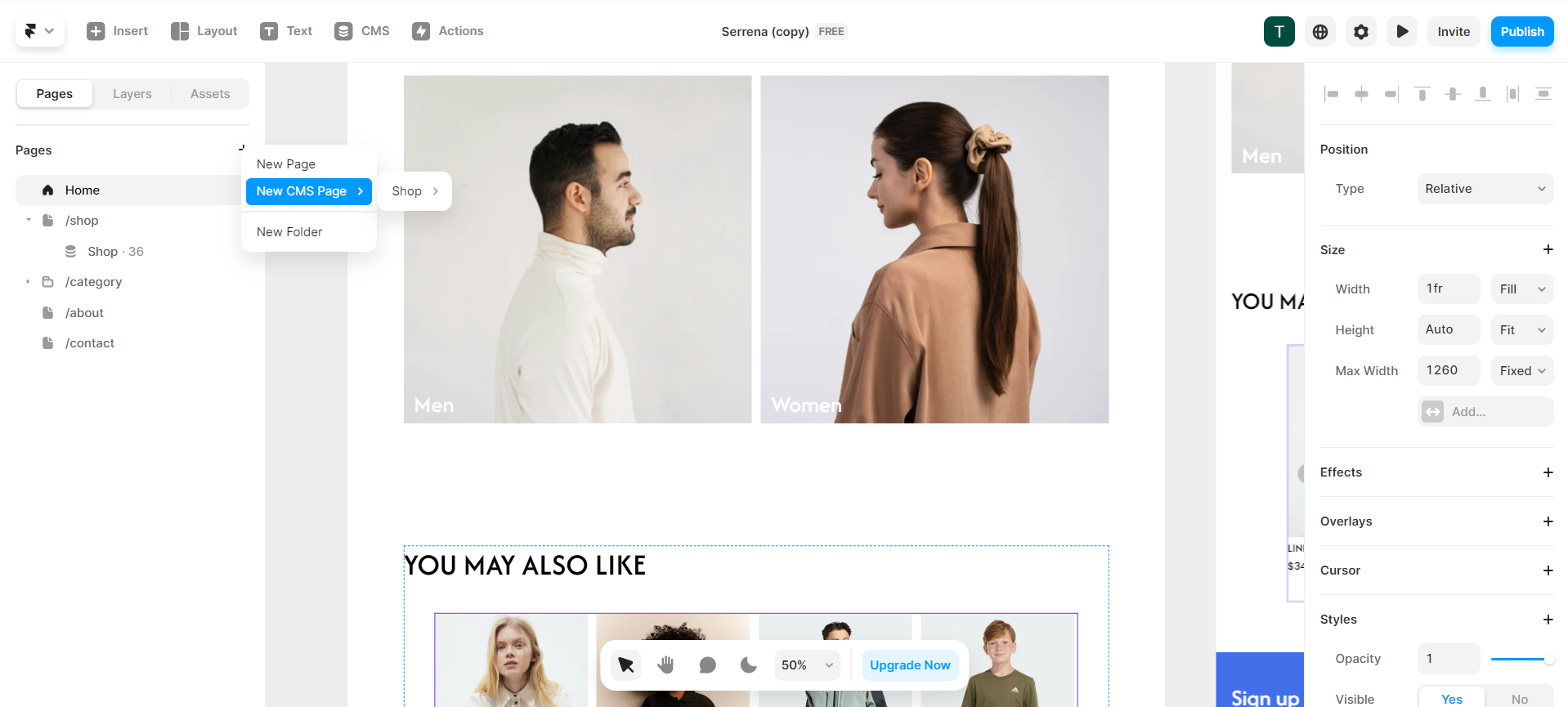
Mobile editor/app
 8.5
8.5
 4.5
4.5
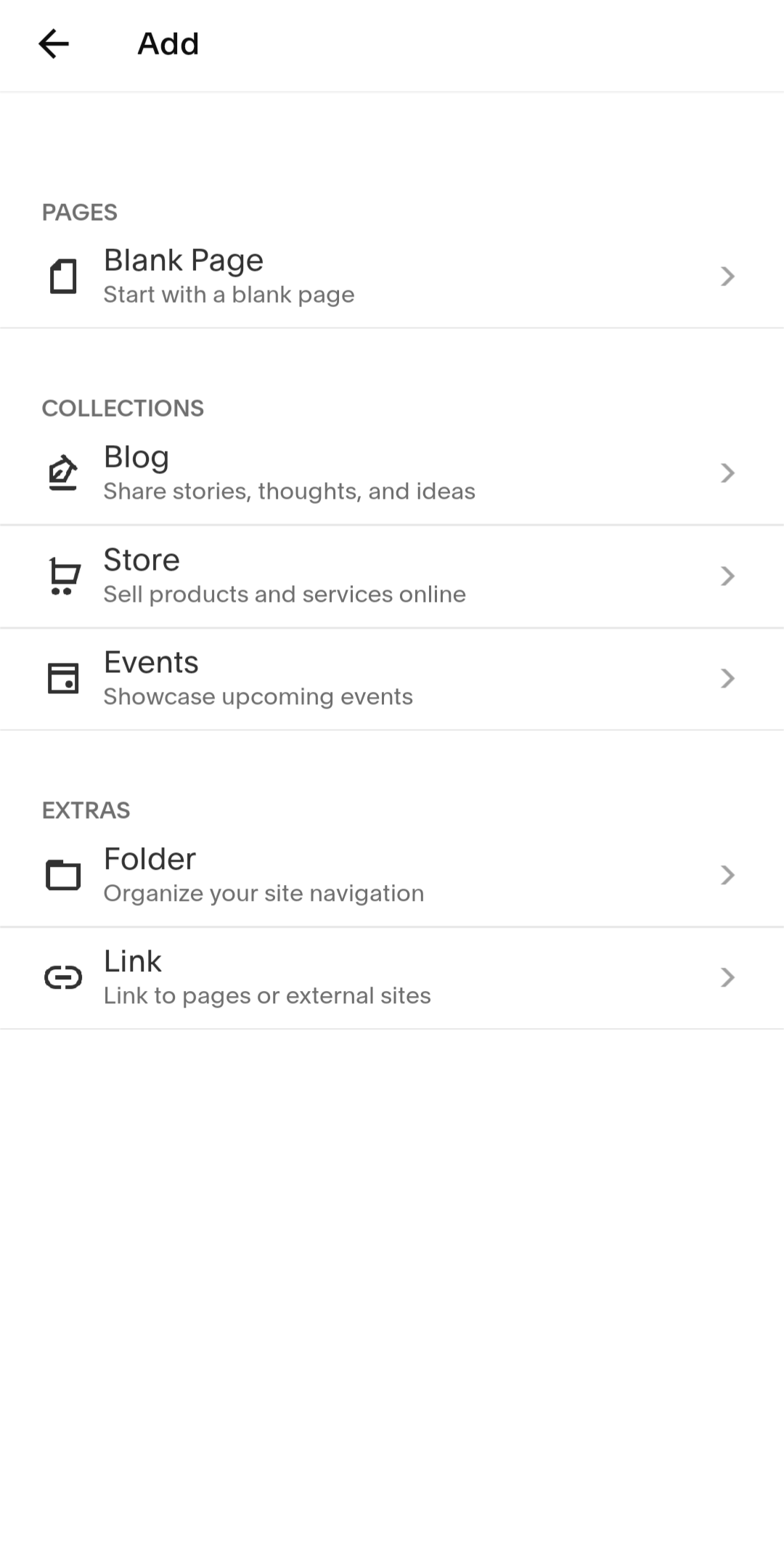
🏆 Winner: Squarespace. Both Squarespace and Framer offer mobile editing options, but they serve different needs. Squarespace has a dedicated mobile app that allows users to manage their site, edit content, view analytics, handle their online store, and schedule social media posts. While not all desktop features are available on mobile, the app provides a good experience for managing your website on the go.
Framer, in contrast, lacks a dedicated mobile app. Users can make edits through a mobile browser, but this approach has limitations and can be less convenient. As a result, Squarespace earns a higher score for mobile editing due to its dedicated app and broader functionality for mobile users.
Product testing options
Product Testing OptionsAssesses the options for trying out platform features before commitment.Score Components:
- Trial quality (40%): Extent and usefulness of the trial or free version.
- Feature accessibility (30%): How many features are available to test.
- Trial duration (20%): Length of the trial period.
- Ease of transition (10%): Smoothness of moving from trial to paid plans.
 7.4
7.4
 6.2
6.2
Overall Result: Squarespace Wins. Squarespace, with a score of 7.4, provides a 14-day free trial that lets users explore most premium features, except for custom code, premium integrations, and removing Squarespace branding. This trial gives users time to assess the platform’s capabilities.
However, Framer scores 6.2. While it offers a free version, there is no trial version available, and only a limited selection of features can be tested. This makes Squarespace the stronger option for users who want to thoroughly evaluate a platform before committing.
 |
 |
|
|---|---|---|
Free Plan |
No | Yes |
Trial Duration |
14 days | No |
Testing Premium Features |
Most, except for custom code, premium integrations and removal of Squarespace branding | Some features with free version |
Money Back Guarantee |
Full refund within 14 days | Only in some regions within 14 days |
Price
PriceLooks at the cost-effectiveness and value for money of each platform.Score Components:
- Plan value (40%): What each pricing tier offers.
- Transparency and clarity (30%): Clearness of pricing structures.
- Flexibility of plans (20%): Range of options to suit different budgets.
- Hidden costs (10%): Additional expenses not included in the plan.
 8.4
8.4
 7.7
7.7
Squarespace and Framer both provide flexible pricing options to meet various needs and budgets.
Squarespace tends to have a slightly higher price, but offers discounts of 25% to 30%, depending on the plan you choose. Framer, by comparison, offers larger discounts of 30% to 50% when billed annually, also based on the plan. Both platforms have enterprise-level plans, with Squarespace pricing tailored to specific requirements and Framer offering customizable options for large-scale websites.

|

|
|
|---|---|---|
Free |
No offering at this amount. |
Free (Free/month): Allows 3 websites built on a framer.website subdomain with Framer branding in the footer. Limited to 1,000 traffic visitors and 1,000 CMS items. |
$10-$15 |
Personal ($12/month): Build a basic website with limited features for personal use. Access to basic templates, mobile-friendly design, and some social media integrations. Value for price: 6.0 |
Mini ($10/month): Removes Framer branding, allows using a custom domain, includes collaboration with an additional cost for extra editors, custom code embedding, e-commerce support, and limited CMS items. Offers a monthly visitor limit of 2,000 and 1GB bandwidth. Value for price: 6.5 |
$15-$25 |
Business ($16/month): Upgrade features with custom domain, SEO tools, marketing tools like email campaigns, and analytics. Value for price: 7.5 |
Basic ($20/month): Offers all Mini features plus increased limits for CMS items (1,000) and traffic (10,000 visitors per month), along with 10GB bandwidth. Value for price: 7.5 |
$20-$40 |
Commerce ($26/month): Perfect for online stores with built-in eCommerce functionality (unlimited products), secure checkout, inventory management, and marketing tools. Value for price: 8.5 |
Pro ($30/month): Enhances Basic plan features with a significant increase in CMS items (10,000), traffic (100,000 visitors per month), and bandwidth (100GB), among other advanced features. Value for price: 8.5 |
$40+ |
Advanced Commerce ($40/month): Cater to high-volume stores with advanced eCommerce features like abandoned cart recovery, product subscriptions, gift cards, and real-time shipping quotes. Value for price: 9.0 |
No offering at this amount. |
location. As a result in rare cases the prices displayed here can differ from the ones you see on their
websites.
Hosting quality
Hosting
qualityExamines the reliability and performance of the hosting solutions.Score Components:
- Uptime (40%): Consistency and reliability of website availability.
- Speed (30%): Loading times and performance.
- Bandwidth and storage (20%): Sufficiency of resources provided.
- Data centers (10%): Quality and distribution of hosting infrastructure.
 7.6
7.6
 7.1
7.1
🏆Winner: Squarespace. Both Squarespace and Framer include reliable hosting services in all their plans, but Squarespace takes the lead with its proprietary cloud-based hosting and a more extensive network of data centers across North America, Europe, and Asia. While Framer provides a solid 99.9% uptime, this guarantee is only available with its enterprise plan.
 |
 |
|
|---|---|---|
Do they offer hosting? |
Yes, included in all of their plans |
Yes, included in all their plans |
Data Centers: |
Squarespace’s data centers are strategically scattered across North America, Europe, and Asia |
4 data centers globally: 2 in US, 1 in Ireland, 1 in Singapore |
Type of hosting: |
Proprietary cloud-based hosting |
Cloud Hosting |
Uptime: |
99.9% |
99.9% |
Uptime Guarantee: |
Yes |
Only for enterprise plan, 99.99% |
Website Speed Optimization
Website Speed OptimizationEvaluates optimization of website loading timesScore Components:
- PageSpeed Score (30%): Google’s score indicating performance optimization.
- Loading Time (30%): The average time until a website is fully interactive.
- Mobile Optimization (15%): Optimization effectiveness for mobile devices.
- Resource Optimization (15%): Optimizing images, scripts, and other heavy resources.
- CDN Usage (10%): Use of CDN to enhance speed across geolocations.
 6.7
6.7
 7.4
7.4
🏆 Winner: Framer. Both Squarespace and Framer prioritize website performance and page speed. Squarespace focuses on responsive design, image optimization, a content delivery network (CDN), code minification, and lazy loading of images. Framer emphasizes similar features like code minification, pre-rendering, caching, and image optimization. However, Framer has a slight advantage when it comes to overall website speed optimization.
 |
 |
|
|---|---|---|
Focus |
Responsive design, Image optimization |
Code Minification, Pre-Rendering |
Performance Tools |
Google Lighthouse, PageSpeed Insights |
Google PageSpeed Insights Integration |
Key Strategies |
Responsive design, image optimization, CDN, code minification, lazy loading of images |
Code Minification, Pre-Rendering, Caching, Image optimization |
Load Times |
0.7s to 9.1 s (Average: 2.9s) |
Varies depending on optimization and website complexity |
Page Speed Scores Range |
20/100 to 93/100 (Average: 62.7/100) |
Varies depending on optimization and website complexity |
Core Web Vitals Improvement |
Emphasis on LCP, FID, CLS improvements |
Emphasis on LCP, FID, CLS improvements |
Squarespace, a widely-used website builder, puts a strong focus on optimizing website performance and page speed. An analysis of Squarespace sites reveals a broad range of page speed scores, from 20/100 to 93/100, with an average of 62.7/100. Load times range from 0.7 seconds to 9.1 seconds, with an average of 2.9 seconds.
Framer, by contrast, combines AI-driven design with a user-friendly interface Load times and PageSpeed scores can vary depending on the complexity and optimization of each site. Like Squarespace, Framer is committed to improving Core Web Vitals (CWV) metrics, focusing on improving Largest Contentful Paint (LCP), First Input Delay (FID), and Cumulative Layout Shift (CLS) for better performance.
Get a head start on website creation with AI
Create a custom website tailored to your business needs 10X faster with 10Web AI Website Builder!
Plugins and integrations
Plugins and integrationsMeasures the range and effectiveness of additional plugins and integrations.Score Components:
- Variety of options (40%): Range of available add-ons.
- Integration smoothness (30%): Ease of integrating plugins into the site.
- Quality of plugins (20%): Functionality and reliability of the options.
- Custom integration capabilities (10%): Support for custom or third-party integrations.
 6.8
6.8
 7.6
7.6
🏆 Winner: Framer. Framer scores 7.6 for its impressive variety of plugins that satisfy a wide range of needs, including forms, video and animation, social media integration, audio, and utility functions. It offers seamless integrations with platforms like Vimeo, MP4, Lottie, GIPHY, Instagram, Twitter, Google Maps, Trustpilot, Spotify, SoundCloud, Apple Music, and more.
Squarespace, with a score of 6.8, lacks an official app store but allows integrations and extensions through custom code injection and third-party tools. While it’s harder to quantify the exact number of available third-party plugins, they cover a broad range of functionalities, including SEO tools and booking systems.
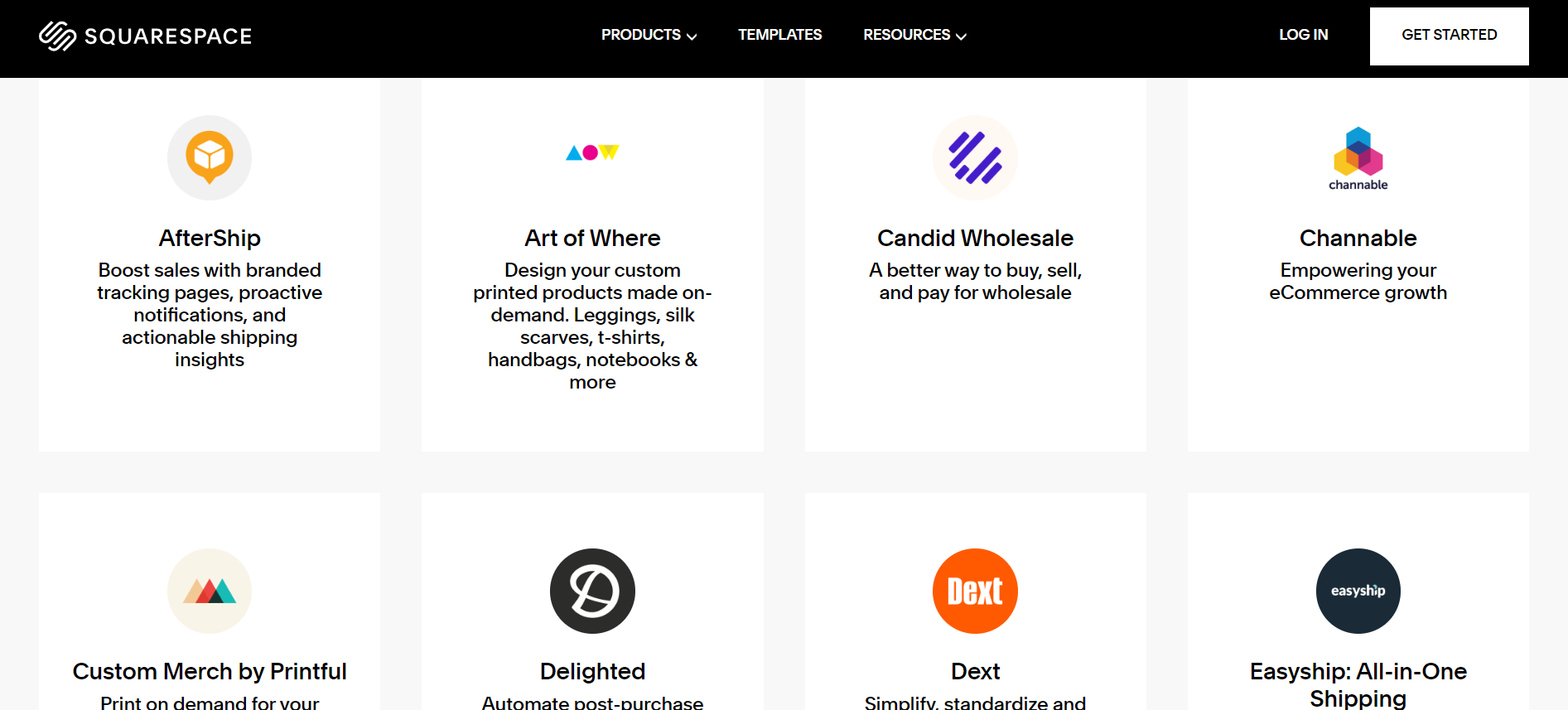
Marketing Features
Design FunctionalitiesRepresents how well each platform allows for creative design and customization of websites.Score Components:
- Template Variety (30%): Range and quality of design templates.
- Customization (30%): Flexibility and options for design alterations.
- User Interface (20%): Ease and intuitiveness of the design process.
- Responsiveness (10%): Adaptability to different devices and screen sizes.
- Innovation (10%): Unique design features and tools.
 8.1
8.1
 7.2
7.2
🏆 Overall Winner: Squarespace. Squarespace stands out with a more broad set of marketing tools, including SEO, email marketing, blogging, social media integration, analytics and reporting, as well as ads and promotions. While Framer offers a solid range of features, it falls short in the area of ads and promotions, giving Squarespace the edge in overall marketing capabilities.
 |
 |
|
|---|---|---|
SEO Tools |
||
Email Marketing |
||
Blogging |
||
Social Media Integration |
Direct linking and selling on social platforms, plus feed displays on-site |
Yes |
Analytics and Reporting |
Detailed insights into website performance and visitor behavior |
Yes, only on higher plans |
Ads and Promotions |
Integration with Google Ads and tools for managing sophisticated ad campaigns |
No |
Customer Support
Customer supportEvaluates the quality and availability of support options.Score Components:
- Response time (40%): Speed of support responses.
- Support quality (30%): Effectiveness and helpfulness of the support.
- Availability (20%): Range of support channels (phone, chat, email).
- Resource richness (10%): Quality of self-help and educational materials.
 7.8
7.8
 5.6
5.6
🏆 Winner: Squarespace. When comparing Squarespace and Framer in terms of customer support, Squarespace comes out on top with its variety of options. It offers live chat, email, and phone support, with live chat and phone assistance available on weekdays from 6 AM to 6 PM PST, and email support available 24/7. In addition, Squarespace provides a community forum and an extensive help center, guaranteeing that users can easily access support whenever needed.
Framer, in contrast, leans heavily on self-help resources, including a community forum and knowledge base. While users can contact Framer’s customer support via email, the lack of clear information on support hours and availability is a downside. This makes Squarespace a more reliable choice for users who need robust and accessible customer support.
Security
SecurityLooks at the platforms’ security measures and data protection.Score Components:
- Data protection (40%): Safeguards for user and customer data.
- SSL and encryption (30%): Implementation of secure connections.
- Compliance (20%): Adherence to industry security standards.
- Regular updates (10%): Frequency of security updates and patches.
 8.8
8.8
 8.2
8.2
🏆 Winner: Squarespace. Squarespace excels in security with a broad approach that includes secure server storage, encryption, strict access controls, and compliance with regulations like GDPR and CCPA. They offer secure hosting, SSL certificates, vulnerability scanning, malware and spam filters, two-factor authentication, and PCI-DSS and GDPR compliance.
Framer also prioritizes security, using Amazon Web Services for hosting and securing data encryption. They focus on secure development, external security testing, and have a bug bounty program. However, despite these efforts, Framer’s security score falls slightly behind Squarespace, making Squarespace the winner in this category.
AI Capabilities
AI capabilitiesMeasures the effectiveness of AI-driven features and tools.Score Components:
- Automation efficiency (40%): Impact of AI on streamlining processes.
- Personalization (30%): AI-driven customization for users or customers.
- AI-Assisted design (20%): Role of AI in website design and functionality.
- Data analysis (10%): Use of AI in interpreting user data and analytics.
 7.5
7.5
 7.6
7.6
 |
 |
|
|---|---|---|
AI Builder |
Framer’s AI builder simplifies the process of creating and optimizing web content |
|
AI Ecommerce features |
AI-powered copywriting, SEO optimization, related product recommendations |
|
AI content generation |
Generates diverse content including product descriptions, website copy, blog posts, social media captions, and email marketing content |
Enhances website creation with localized content, text rewrite functionality, and headline generator |
Additional AI features |
SEO optimization suggestions, email marketing insights, inventory management insights, social media content and ad suggestions |
AI Style and AI Photo Generating and Editing tools for customization and image creation |
🏆 Winner: Framer. Framer leads with a score of 7.6, thanks to its strong AI capabilities. It offers an AI builder, content generation and localization, as well as advanced style and photo editing tools. These features make Framer a powerful platform for efficiently creating and managing websites, giving it the edge in AI functionality.
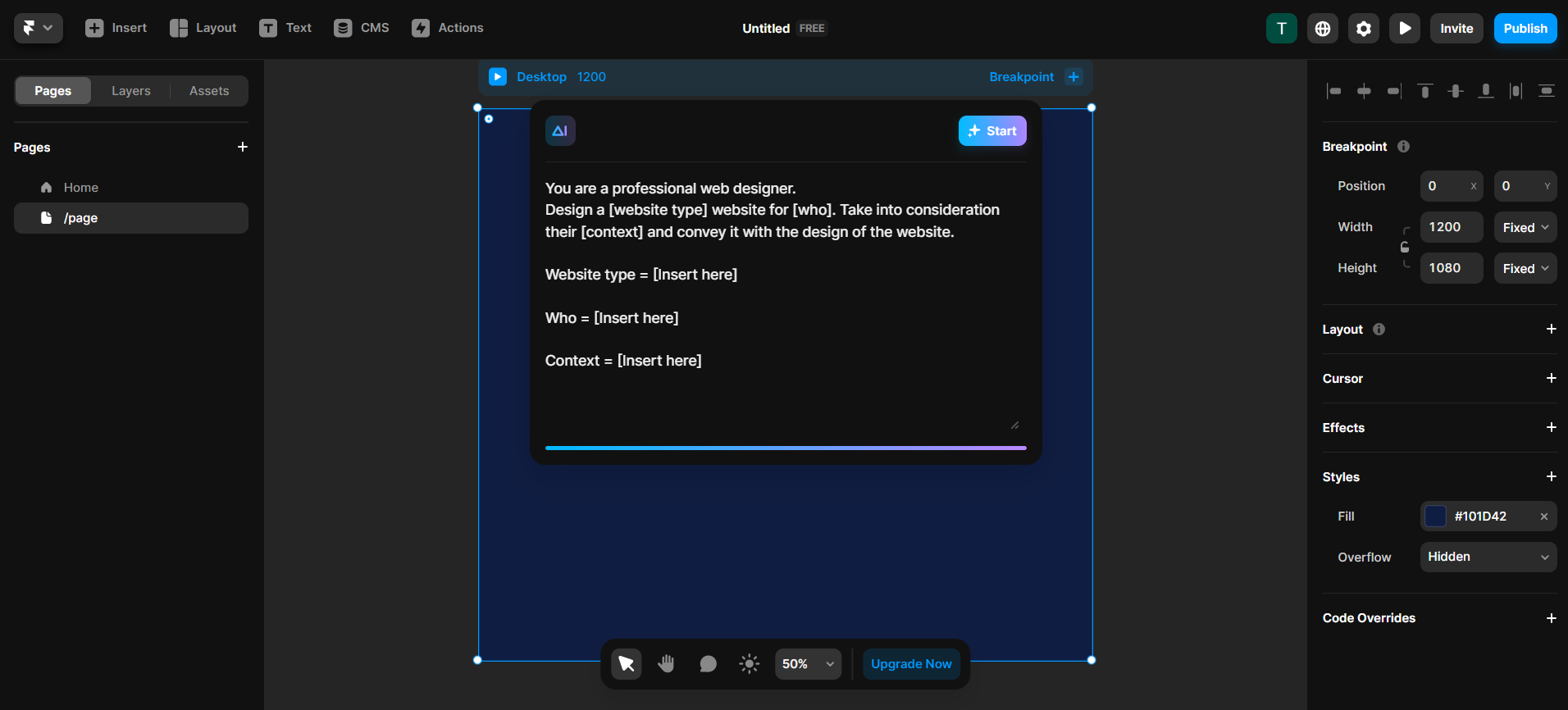
Squarespace, with a score of 7.5, also provides various AI-driven features, particularly in improving the ecommerce experience and content generation. However, it falls short of offering a fully automated AI builder, which gives Framer the upper hand in this comparison.

User Management
User ManagementAssesses the platforms’ capabilities in managing user roles, permissions, and accessibility.Score Components:
- Role Customization (40%): Flexibility in creating and defining user roles and
permissions. - Ease of Management (30%): User interface and tools for managing users.
- Access Control (20%): Effectiveness of access control measures for different user
levels. - Scalability (10%): Ability to manage a growing number of users efficiently.
 7.4
7.4
 7.4
7.4
🏆 Winner: Tie. Both Squarespace and Framer offer strong user management features, allowing for detailed control over who can edit and manage the website.
- Squarespace’s Personal Plan allows one owner, while the Business and Commerce Plans permit two collaborators with varying access levels. The Enterprise Plan offers unlimited users.
- Framer’s Team Basic plan supports up to 5 editors, and the Team Pro plan allows for up to 10 editors. Both platforms provide flexible options for managing multiple users, making this category a tie.
Squarespace User Roles and Access Levels:
| Role | Description | Access Highlights |
|---|---|---|
| Owner | The primary user who created the website and has full access. | Full site access, including billing, site settings, content editing, and member management. |
| Administrator | Users granted nearly full access to manage the site alongside the Owner. | Access to most areas except for some owner-specific settings like ownership transfer. |
| Content Editor | Users focused on adding and managing site content without full site access. | Can add, edit, and delete content on pages, blog posts, and manage comments. |
| Billing | Users who manage the subscription and billing details. | Access to billing information and the ability to update subscription details. |
| Store Manager | Users who manage the ecommerce aspects of the site. | Can manage inventory, fulfill orders, manage customers, and view sales analytics. |
| Custom | A role defined by the site owner or administrators with specific access. | Customizable access as defined by the Owner or Administrators, can vary widely between sites. |
Framer User Roles and Access Levels:
| Role | Description | Access Highlights |
|---|---|---|
| Designer | Focuses on the aesthetic and UI/UX aspects of the website. | Can create and modify design elements, utilize animation libraries like Framer Motion, and implement accessibility settings. |
| Content Editor | Manages and curates content for the website, including text, images, and other media. | Can edit CMS content, use localization features for different regions, and modify SEO settings. |
| Developer | Works on more technical aspects, such as custom code and integrations. | Has access to deploy options, can use custom domains, manage project permissions, and apply custom code for further optimization. |
| Project Manager | Oversees the project, coordinating between different roles and ensuring the project meets its deadlines and goals. | Can invite collaborators, assign roles and permissions, and manage versions and rollbacks for efficient site management. |
| Collaborator (General) | A role that can encompass various levels of access based on project needs, including design, content, and deployment tasks. | Access can be customized to include a mix of design, content, and deploy permissions based on the project’s needs and the individual’s role within the team. |
Additional Features
 |
 |
|
|---|---|---|
SSL Certificate |
||
Custom Domain |
||
Free Custom Domain Included |
||
International Domains |
||
Mobile Responsive |
||
Page Speed |
||
Website Builder Mobile App |
||
Convert a Website To An App |
||
Website Analytics |
||
Multilingual Sites |
||
Multiple Users |
Squarespace vs Framer: User Feedback
Squarespace is famous for its intuitive interface and versatile tools, making it a great choice for users without technical expertise. It offers a wide range of features like website creation, SEO, and online selling, catering to various needs. Customers often praise its strong customer support and attractive, professional templates that help create a polished online presence. However, some users experience challenges with domain transfers, limited customization options, and find the pricing slightly high. There are also occasional complaints about template rigidity, missing features, and customer service inconsistencies.
However, Framer is highly rated for its no-code approach to web and prototype design. It simplifies the design process with extensive tutorials, templates, and drag-and-drop functionalities. Users also value its integration with tools like Figma, AI-generated responsive designs, and real-time collaboration features. However, newcomers may find the learning curve steep, and there are some criticisms about limited customer support and restricted features without premium access. Despite these drawbacks, Framer is praised for boosting creativity and efficiency in web development.
The making of this blog
We followed a clear, step-by-step process to write and research this article.
Squarespace vs Framer: Final verdict
Squarespace and Framer each bring unique strengths to the table, making them suitable for different types of users and projects.
- Squarespace (Overall Grade: 7.9/10) is a website builder known for its easy-to-use interface and broad range of features. It offers an easy website creation process with a variety of professional templates, strong ecommerce capabilities, and reliable customer support. Squarespace is the ideal choice for users who want an all-in-one solution to create and manage their online presence without requiring advanced technical skills.
- Framer (Overall Grade: 7.1/10) shines with its AI-driven design features and extensive customization options. It’s a powerful platform for designers and developers aiming to build highly interactive and responsive websites. Although it has a learning curve and lacks built-in ecommerce features, Framer’s advanced design tools and real-time collaboration make it a great option for creative professionals and teams focused on detailed, user-centric web projects.

|

|
|
|---|---|---|
Design functionalities & templates |
8.0 |
8.5 |
Ease of use |
8.3 |
7.1 |
Ecommerce |
8.2 |
5.9 |
Website editors |
8.3 |
7.6 |
Product testing options |
7.4 |
6.2 |
Price |
8.4 |
7.7 |
Hosting quality |
7.6 |
7.1 |
Website speed optimization |
6.7 |
7.4 |
Plugins/extensions and integrations |
6.8 |
7.6 |
Marketing features |
8.1 |
7.2 |
Customer support |
7.8 |
5.6 |
Website security |
8.8 |
8.2 |
AI capabilities |
7.5 |
7.6 |
User management |
7.4 |
7.4 |
Squarespace vs Framer: FAQ
Which platform is better for ecommerce, Squarespace or Framer?
Can I use Squarespace and Framer for creating informational and business websites?
How do Squarespace and Framer compare in terms of design functionalities and templates?
Which platform is easier to use for beginners?
How do the pricing and value compare between Squarespace and Framer?
Which platform offers better customer support?
Are there any significant differences in website speed optimization between the two platforms?
Which platform is better for users looking for advanced AI capabilities?









